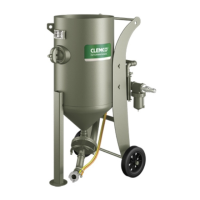17
5.5 Shut-down
(1) Empty all abrasive.
Blast machine not in use > 1 day (abrasive could get moisture).
5.6 Shut-down when moving equipment
No special measures required.
6 Maintenance
6.1 General
During operation blast machines are exposed to wear. In order to ensure safe operation and high
efficiency the blast machines should be maintained according to the following check lists.
Prior to maintenance, make sure that the air valve of the compressor is closed and the whole
system is depressurized!
6.2 Daily check list
(1) Pot.
− Check gasket of filling port and replace it at first sign of wear
(replacement possible from outside).
− Check pop-up valve and replace it at first sign of wear.
(2) Airline and blast hose.
Check hoses for sharp bends, causing high loss of energy and
rapid wear.
No vehicles should pass over hoses!
(3) Nozzle and nozzle holder.
− Check nozzle gasket and replace it at first sign of wear.
−
Check nozzle and nozzle holder (thread) for wear and
replace them if necessary.
(4) Remote control valve and
accessories.
− Open petcock of remote control valve RMS 2000A or RMM
50A and check for water. If water is detected check moisture
separator (see section 5.3)
−
Check rubber button of deadman handle for wear and
replace it if necessary.
− Check fittings of remote control valve for tightness.
−
Check all electric and pneumatic connections of electric
panel RME-1 or RME-2 (electric remote controls).
6.3 Weekly check list
(1) Moisture separator.
Remove and check filter element. If necessary clean filter and sight
glass with soap and warm water and dry it with compressed air.
A dirty filter causes loss of pressure in the system!
Check for wear or blockage and clean or replace interior body.
(3) Air hoses and blast hoses.
− Check all couplings and screws for wear or breakage and replace
them if necessary.
−
Check whole blast hose by hand for soft spots (reduced wall
thickness) and replace it immediately when soft spots are

